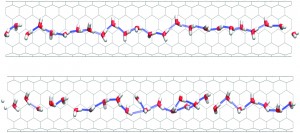The following articles in PCCP were the top ten most accessed in January:-
Graphene oxide for effective radionuclide removal
Anna Yu. Romanchuk, Alexander S. Slesarev, Stepan N. Kalmykov, Dmitry V. Kosynkin and James M. Tour
DOI: 10.1039/C2CP44593J
Evidence of catalyzed oxidation of Li2O2 for rechargeable Li–air battery applications
Jonathon R. Harding, Yi-Chun Lu, Yasuhiro Tsukada and Yang Shao-Horn
DOI: 10.1039/C2CP41761H
Electronic interactions and charge transfers of metal atoms and clusters on oxide surfaces
Gianfranco Pacchioni
DOI: 10.1039/C2CP43731G
Proton reduction to hydrogen in biological and chemical systems
Phong D. Tran and James Barber
DOI: 10.1039/C2CP42413D
Graphene-based electrochemical energy conversion and storage: fuel cells, supercapacitors and lithium ion batteries
Junbo Hou , Yuyan Shao, Michael W. Ellis, Robert B. Moore and Baolian Yi
DOI: 10.1039/C1CP21915D
Increasing organic solar cell efficiency with polymer interlayers
Felix Deschler, Daniel Riedel, Bernhard Ecker, Elizabeth von Hauff, Enrico Da Como and Roderick C. I. MacKenzie
DOI: 10.1039/C2CP43876C
Plasmonic photocatalysts: harvesting visible light with noble metal nanoparticles
Peng Wang, Baibiao Huang, Ying Dai and Myung-Hwan Whangbo
DOI: 10.1039/C2CP40823F
Temperature effects in dye-sensitized solar cells
Sonia R. Raga and Francisco Fabregat-Santiago
DOI: 10.1039/C2CP43220J
Persistent misconceptions regarding SERS
Martin Moskovits
DOI: 10.1039/C2CP44030J
Reversible chemical delithiation/lithiation of LiFePO4: towards a redox flow lithium-ion battery
Qizhao Huang , Hong Li , Michael Grätzel and Qing Wang
DOI: 10.1039/C2CP44466F
We hope you enjoyed reading the articles – please sign up for the free PCCP table of contents e-alerts to make sure you keep up to date with the latest research being published in the journal
On behalf of the Editorial Board of PCCP, we invite you to submit your best research to us today!



















 A recent theoretical study by Zhijan Wu, Aimin Ren and co-workers predicts novel BODIPY derivatives with interesting and potentially very useful nonlinear optical properties.
A recent theoretical study by Zhijan Wu, Aimin Ren and co-workers predicts novel BODIPY derivatives with interesting and potentially very useful nonlinear optical properties.